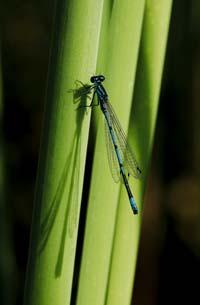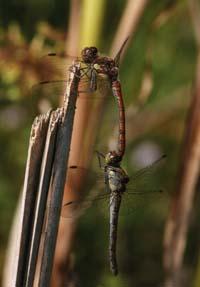Brocheta, king of the well

Spring has arrived, the well has begun to resurge and the skewer must recover his property. In winter it has not been visible, the nymph of the skewer has resided in the water. It has fed on invertebrates and small vertebrates and has been preparing the body for the great day. When the conditions of the area are adequate, they will be evacuated. She climbs up a branch and the skin she has now fixed is empty like an old shell, from where the winged skewer will be born, an elegant insect dressed in robust body and with large wings.
With the first princes of the day, the wings open and prepare to fly. Like a helicopter that turns on to heat the engine, vibrate the wings to dry them well and put the muscles in the flight point. It is a decisive moment, it has to fly as soon as possible to take the best territory.
For the Male Skewer it is necessary to own a territory, be the king of the well, so that it can fulfill the two great objectives of the adult age: to take strength, it must feed as quickly as possible and as quickly as possible, and try to reproduce later. It will not be easy task, compete with other males and the female will not facilitate things either. The king of the well, however, will use the force: with the two pairs of keys that it has in the tail, subject to the female by the back of the head, which once inclined the body towards the thorax of the male, the cap.
Struggle for life

The struggle will be something daily until he is king and has to be hard to maintain the territory. It is not the only male skewer of the lagoon. Looking at the environment, see a lot of brooches of both its species and other species. With all of them you will have to compete, you will know the crudest and cruel side of life, but you have no choice if you want to advance. The instinct tells him to drive away all those who approach.
The skewer is well prepared for arrival. It has thick jaws, pointed vision and machinery of great power to fly. It has a robust thorax, endowed with magnificent muscles, to which the main weapon of the skewer is associated: the wings. It has four wings, large and bright.
Well, each south can move separately. And that gives it an enormous capacity of manoeuvre. There will be no two in the world who have that ease to go back and advance in the air, up and down, to the left and to the right... more, can stay still, as suspended in the air. Despite its ability, it is not thought to be slow, much less; some species of brooches reach speeds of almost 60 km/h. So think about the few possibilities that prey have before this aircraft prepared for war.
The skewer easily reaches the speed in a short time. This is mainly due to some of its structures in the wings. These structures are pterostigmas, one in each south, in the center or on the edge, according to the species. The pterostigma is similar to a counterweight and has the function of stabilizing the flight, similar to the balancers of the machines.

However, the wing's own structure also has a lot to do with the skewer's flight. In fact, the south is not completely flat: it is crossed by a wide vein and the membrane between the veins is not flat, it has relief. Thanks to this relief, when flying, turbulence occurs on the surface of the wings that help the flight.
A little mystery
The flight of the skewer and hunting techniques are quite complex, and it seems that the skewer has many skills that still have no explanation. For example, the male skewer is able to approach a female, a male competitor or an unnoticed prey. In fact, the persecuted (another skewer or prey) sees the image of a standing object, that is, the aggressor is in the same position in the retina, even though the reality is in progress. But by the time he realizes it is too late: the aggressor is above.
You need a great skill to do it with the prey or with the other boat stopped. But the ability of the male skewer goes beyond, since, even though jazz flies, the aggressive skewer will take a tour that will seem to him to remain in the same place.
This type of chase is called motion camouflage, is very complex - as seen - and is also used by other insects. It is unknown since when this technique is used in the males of some species of brooches and, however, we do not realize. It is not too long for researchers to observe this technique -- in the case of the skewer, not a decade after discovering motion camouflage -- either. And today, the most advanced technologies are needed to investigate motion camouflage, such as high-speed cameras or computational models.

The life of the skewer will also go at full speed. Only a few days will be the king of the well. The passage of time has aged, has had numerous fighting and many other love stories. A few days ago the season has gone and is tired. From behind, the new generations push; the pressure exerted by juveniles of brooches is increasing, to the point that, despite not wanting, in a fight it collapses. That is the fate of the king.
However, the well will remain alive; as when the fallen king was born, life is drunk. The prince who has caught him will take care of the territory as well as the fallen kings: the other worm will spend the day chasing, hunting, and the females who are in his path will catch them with their hooks and cover them so that they lay their eggs in the well. At the arrival of the winter, it seems that the calm will prevail, since, although we will not see, the nymphs grow and grow in the water, preparing for the arrival of the spring.
Agur, putzu maite
Unfortunately, the well in which the brooches of this article lived is only in our imagination. There was once; in fact, it was in the area of Alegia (Gipuzkoa) and was destroyed last September by the excavators to create an industrial estate.

In this well were the nymphs of the new generations of brooches - 29 of the 36 species listed in Gipuzko-, among which were the descendants of the fallen king and the subsequent ones. But this spring and summer, young brooches will not be born. The fable and the world lose a small kingdom full of life.
However, we have been fortunate: thanks to the memories and chamber of one of the few friends who knew that well, we have known that kingdom.





